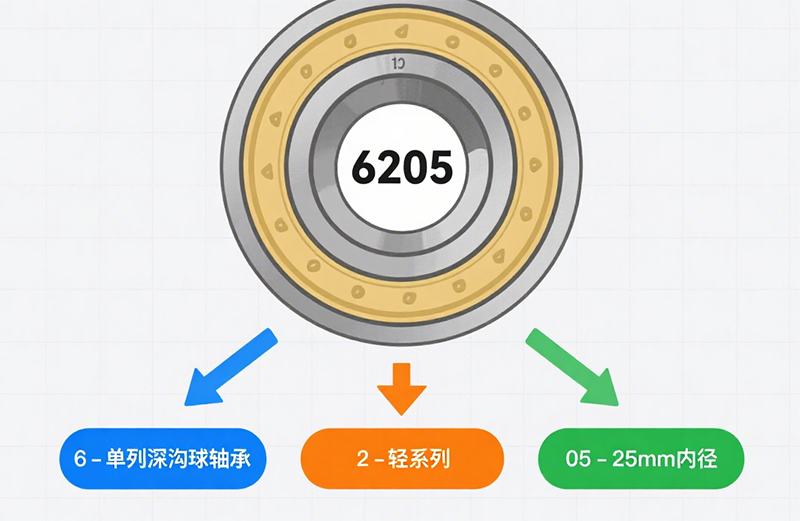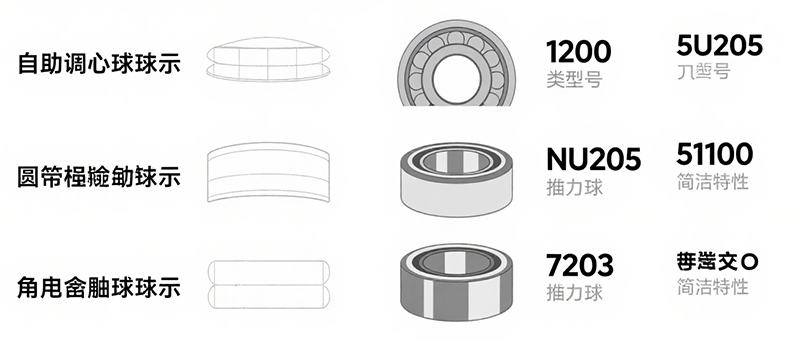Vad betyder lagersiffrorna? En guide till att läsa dem
What Do Bearing Numbers Signify? How can you interpret bearing numbers correctly? These are among the most frequently asked questions regarding metal bearings across various industries.

If you’ve ever found yourself pondering, “What do the numbers on a bearing mean?”, you’re far from alone. At first glance, bearing codes can seem confusing—but once you grasp their structure, they become an incredibly handy tool. They let you quickly identify a
bearing’s type, size, and key specifications, providing all the essential details you need.
This article is designed to help you understand how to read bearings and decode bearing numbers using critical dimensions like bore diameter,
outer diameter, and width.
How Bearing Numbers Function
The base code of a bearing number is part of an international labeling system. This system enables engineers, manufacturers, and maintenance experts to rapidly identify a bearing’s design and fit. Following a structured format, base codes reveal details such as the
bearing’s type, series, bore size, and other supplementary features.
Most standard bearings are labeled with a multi-digit number (for instance, 6205). Once you familiarize yourself with the format, decoding these numbers becomes a simple process. This not only saves time but also reduces errors when selecting or replacing bearings.
How to Read Bearing Numbers
To decode a bearing number, you can break it down into three
kärnkomponenter: bearing type, series, and bore size. Additionally, suffixes add extra details about specific features.
1. Bearing Type (First Digit)
What Do Bearing Numbers Signify? The first digit in the bearing number indicates the type of bearing. Here are the common designations:
Each bearing type is engineered for different load scenarios. For example, angular contact bearings excel at handling combined radial and axial loads in a single direction. In contrast, single-row
spårkullager med djupa spår are suitable for lighter radial and axial loads acting in both directions.
It’s important to note that some bearing types—such as
rullager—may start with a letter (e.g., “N” for certain roller bearings) instead of a number. These prefixes can vary between manufacturers, so it’s always wise to refer to the manufacturer’s catalog for clarity.
2. Bearing Series (Second Digit)
The second digit relates to the bearing’s diameter series and durability. The designations are as follows:
- 0 = Extra light
- 1 = Extra light thrust
- 2 = Light
- 3 = Medium
- 4 = Heavy
- 8 = Extra thin section
- 9 = Very thin section
Choosing the right series ensures the bearing can handle the expected load without being unnecessarily large or heavy.
3. Bore Size (Last Two Digits)
The last two digits of the bearing number determine the inner (bore) diameter in millimeters, with a simple rule—except for the combinations 00 to 03, which have fixed values:
- 00 = 10 mm
- 01 = 12 mm
- 02 = 15 mm
- 03 = 17 mm
- 04 = 20 mm (calculated as 04 × 5 = 20 mm)
- 05 = 25 mm (calculated as 05 × 5 = 25 mm)
This standardized sizing makes it easy to match or replace bearings across different brands and industries.
Common Suffixes in Bearing Codes
Suffixes in a bearing number provide more detailed information about the bearing’s features. While these can differ between manufacturers, some widely used examples include:
- ZZ = Equipped with metal shields on both sides
- 2RS or DDU = Fitted with rubber seals on both sides (2RS for non-contact seals, DDU for contact seals)
- C3 = Has greater internal clearance than the standard
- NR = Includes a snap ring groove
- K = Features a tapered bore
- P5, P6 = Indicates precision grade (P5 for higher precision than P6)
Note that these suffixes are not part of the base code.

Close-up of radial kullager placed on a black background.
Examples of Different Bearing Codes
To make decoding clearer, let’s look at a few real-world examples of bearing codes and their meanings:
Example 1: Bearing Number 6304
- 6 = Single-row deep groove kullager
- 3 = Medium series
- 04 = Bore diameter of 20 mm (04 × 5 = 20 mm)
Example 2: Bearing Number 7206
- 7 = Single-row angular contact ball bearing
- 2 = Light series
- 06 = Bore diameter of 30 mm (06 × 5 = 30 mm)
Understanding these labels helps you match a bearing to its intended function—whether it needs to handle high speeds, heavy loads, or resist contaminants.
Tips for Identifying Bearings Without Codes
Sometimes, a bearing’s number may be unreadable or missing. In such cases, you can still find the right replacement by measuring three key dimensions:
- Inner Diameter (ID): Also called the bore diameter, this is the size of the internal hole that fits over a shaft.
- Outer Diameter (OD): The measurement across the outer ring of the bearing.
- Width (W): The total thickness of the bearing from one side to the other.
Once you have these measurements, cross-reference them with a bearing dimension chart or use an online bearing finder tool. This will help you identify the likely bearing code or basic designation.
For example:
If you measure a bearing with a 25 mm bore, 52 mm outer diameter, and 15 mm width, it is most likely a 6205 bearing. From there, you can choose the appropriate suffix based on the bearing’s intended application.
What Do Bearing Numbers Signify? In critical applications, always match the exact specifications when replacing a bearing. This ensures safety, efficiency, and a longer lifespan for your equipment.
Bearings at Statewide Bearings
Bearing numbers are a compact, standardized way to describe every key detail of a bearing—from its type and bore size to its seal type and load capacity. Learning to read these numbers lets you select the right bearing with confidence, avoid costly delays, and ensure optimal performance.
Statewide Bearings is a trusted bearing distributor with access to top global manufacturers, including NSK, FAG (Schaeffler), and Timken.
What Do Bearing Numbers Signify ,That’s all for now。
Their product range includes:
Ball-type bearings
Cylindrical roller bearings
Sfärisk rullager
Taper roller bearings
Plain bearings & bushings
Split bearings
Slew ring bearings
Needle roller bearings
Wider inner ring bearings
Pacflange self-lubricating bearings

